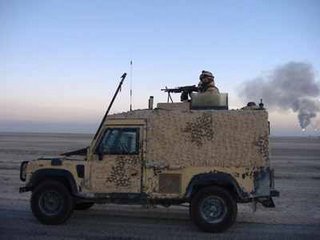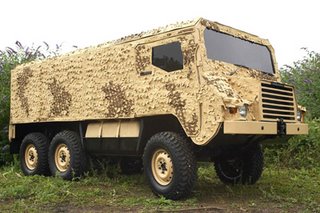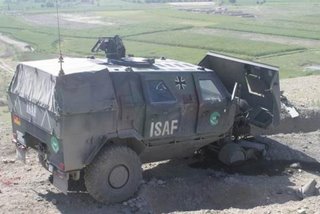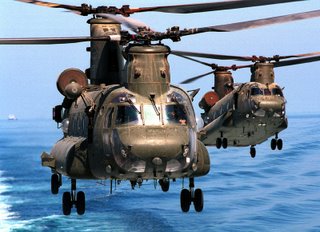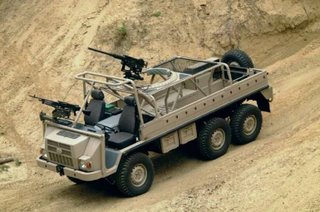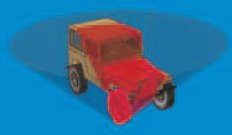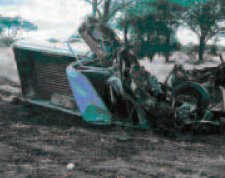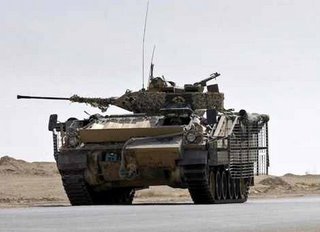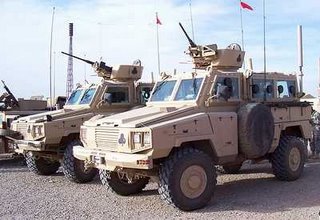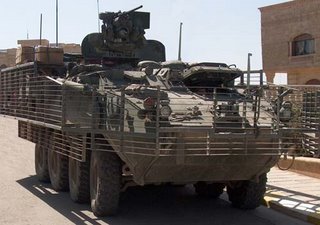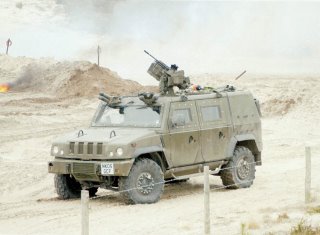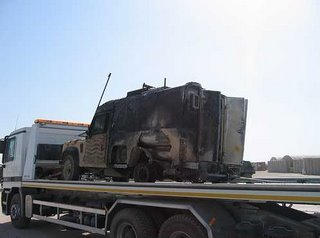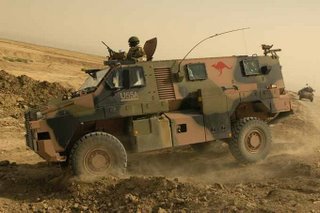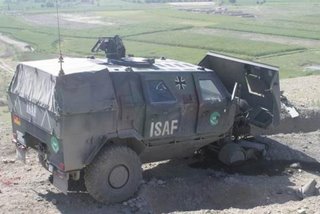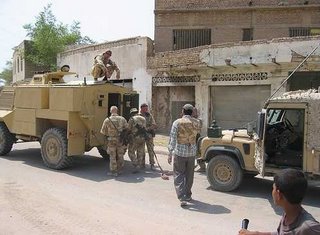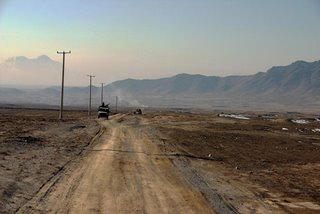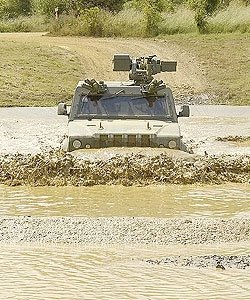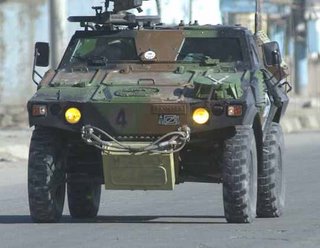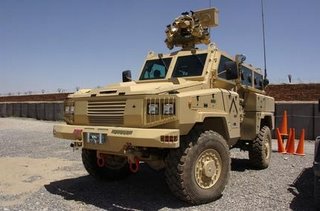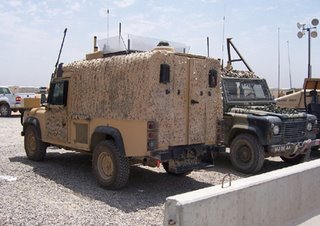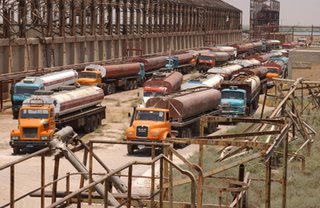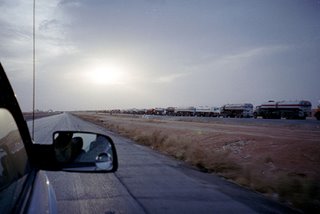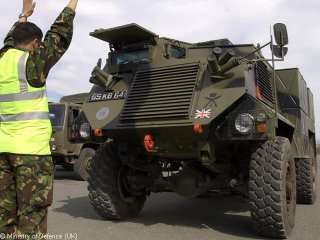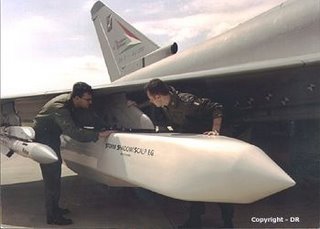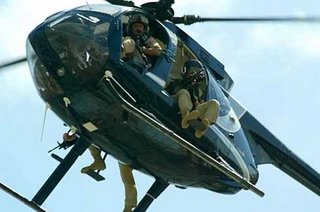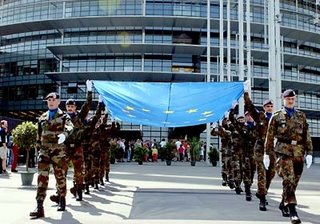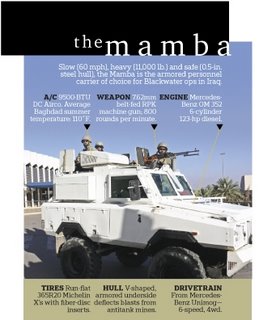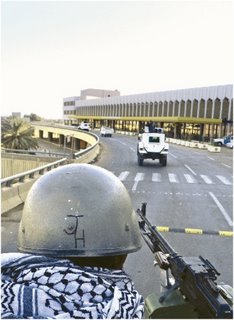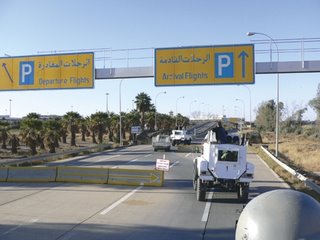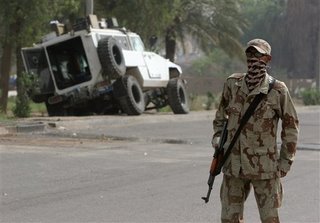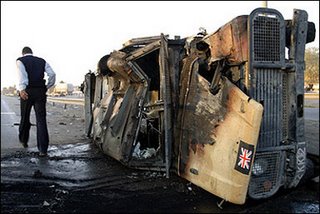 Two weeks ago
Two weeks ago, alongside Christopher Booker in
The Sunday Telegraph, we set ourselves the apparently simple task of drawing to the attention of the wider community the dangerous inadequacies of the equipment supplied to our troops in Iraq (and also Afghanistan), in particular the so-called "Snatch" Land Rover.
We were by no means
the first to raise this issue, but if ever there was an open and shut case, this seemed one to tackle and one ideally suited for a campaigning blog like ourselves.

In terms of exposure, I suppose we can call our activities successful, in that Booker did two articles,
here and
here, and
The Sunday Times picked up our posts from the blog. Based almost entirely on our research, it ran last week a front-page story, a focus piece and an editorial. We have also tabled, through our friends and allies in the House of Commons and the Lords over 40 parliamentary question (with more to follow) and the issue has been raised both in
defence questions in the Commons and in a debate in the
House of Lords.
Then, last week, the issue led in the
letters page of the
Sunday Telegraph and this week it does so in the Sunday Times, the lead letter being from Andrew Adams, an ex-Captain of the Royal Electrical & Mechanical Engineers, now a chartered engineer, living in Ruislip, Middlesex.
He writes, under the heading: "Army needs equipping with a fighting chance":

Thank you for highlighting the risks that British soldiers face when using Snatch Land Rovers.
As a former British Army engineering officer who led Snatch vehicle repair platoons during the last two summer tours of Iraq, I have seen first- hand the lack of protection they offer our troops. They are not fit for purpose - unstable, unreliable, overloaded with desert modifications (such as radios and air-conditioning) and, most importantly, lack sufficient blast protection. In addition, there were insufficient spares within the logistics system to enable us to quickly repair broken vehicles — spares delays of up to a month were common.
I chose to resign my commission rather than face another tour with dangerous "make do and mend" equipment.
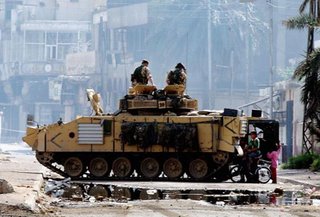
There then follow six more letters, each making good points, the first of the remainder being from Keith Armstrong of Whitley Bay, Tyne and Wear, who refers to the MoD spokesman, Brigadier Bill Moore, in the
Sunday Times piece. He defended the use of "Snatch" Land Rovers on the basis of the effect on civilians of Challenger tanks and Warriors roaring through Basra. Thus does Keith Armstrong write:
Surely Brigadier Bill Moore should be more concerned with the security of soldiers fighting in Iraq rather than their ability to interact with the local community, who currently seem to be taking advantage of our inability to supply the right vehicle. Anyway most of the vehicles have been attacked on main roads, and not in narrow side streets.
The government proclaims what a wonderful job the armed forces are doing on our behalf, but it is trying to have the job done on the cheap.
Malcolm Paton then makes the perfectly reasonable point that, while we are preparing to spend billions on renewing the "independent" nuclear deterrent,
…we have reports of the threat to Hercules aircraft from a lack of fire protection in the fuel tanks. Considering the number of low-level sorties currently flown by the Hercules in dangerous theatres - and the number of fatalities — this has caused great concern.
"My son has just passed out from the Infantry Training Centre, Catterick," Paton writes. "I doubt that our independent nuclear deterrent will be of any comfort to him when he undoubtedly serves in both Iraq and Afghanistan."
It is a measure of the lack of debate in the issue of European defence integration that the man does not pick up on the fact that we are committing £14 billion on the FRES programme, re-equipping and re-structuring the Army so that it can fulfil Blair's commitment to the European Rapid Reaction Force.
This, however,
Christopher Booker deals with from the position of his ghetto in the his
Sunday Telegraph column, sandwiched in between a worthy, but hardly earth-shattering piece on the latest round of absurdity on the metric rules, and a piece by James Le Fanu on the new diet pill.
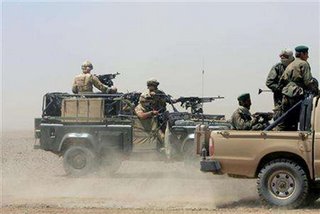
Headed "A fantasy force for which our soldiers pay with their lives", Booker reminds readers that, when he wrote about the Land Rovers two weeks ago, he set the issue in the wider context of our disastrous defence policy, by which our troops in Iraq and Afghanistan are starved of proper resources in order to spend billions on equipping our forces to play their part in the planned European Rapid Reaction Force.
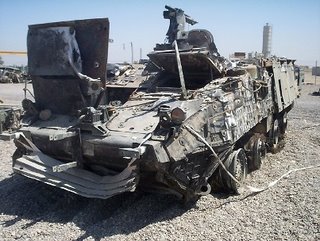
The
FRES concept which will form the heart of the ERRF - for which, we repeat, the MoD has allocated £14 billion - will rely on medium-weight, air-portable armoured vehicles, and is reported to be considering vehicles
like these. One of these is the Piranha, on which the Stryker, currently used by US forces in Iraq, is based. And, as events have demonstrated, this too is highly vulnerable to IEDs.
To support his argument about the EU plans, Booker refers us to
Karl von Wogau document on the "Implementation of the European Security Strategy", which we raised on this blog, having been alerted to its existence by a UKIP member of the Ind-Dem team in Brussels – and example of UKIP actually providing value for money.

Anyhow, returning to the crop of letters in
The Sunday Times, Hugh O’Daly of Sheffield writes that the way ahead "is to replace these Land Rovers quickly by bringing in the wheeled Saxon armoured personnel carriers that the army already has in Europe."
O'Daly suggest that additional upgraded protection could be easily added to the sides, if needed, suggesting that, "this vehicle is larger and tougher than the Land Rover and is a modern replacement for the old armoured Pigs that operated in Northern Ireland." He concludes that, "there is no point patrolling towns in Warrior armoured personnel carriers and Challenger tanks, as is happening, as they are too big and heavy for the town streets. In addition they send the wrong message."

Yet,
as our own readers will know from this blog, Saxons have been deployed in Basra, and for a time operated alongside 'Snatch' Land Rovers (see left). They have since been withdrawn – probably rightly. Despite their formidable appearance, they are actually no more than Bedford trucks with an armoured box on top, which confers little more ballistic protection than the Snatch. They confer no significant level of mine/IED protection and, even in the present configuration, are notoriously top-heavy. With additional protection they would be dangerous unstable.
However, the point about "sending the wrong message" by putting Warriors and Challengers on the streets is a good one. A wheeled vehicle is often chosen because it is regarded as looking "less aggressive" and is thus less likely to provoke civilian reaction. And, in this context, not only is the RG-31 a wheeled vehicle, it is an inch narrower than the Saxon.
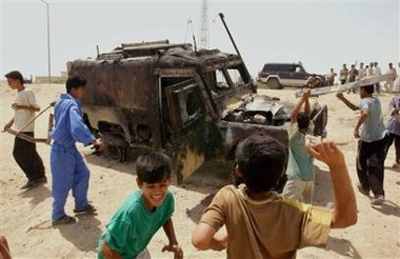
Three more letters complete the "bag", which can be read from the link provided above, but the last merits special comment. This is from Anthony Philips of Salisbury, Wiltshire, who remarks that "nothing changes":
Almost 50 years ago, when serving in Cyprus, I lost two colleagues in a land mine explosion. The official response was to cover the floors with sandbags and, on frequently used tracks, reverse the vehicles over considerable distances to minimise the danger to front seat occupants.
That speaks volumes for the military mind, which constantly ignores the reality of operational threats and developments in warfare. I recall that, in the Peninsular war, there was enormous resistance to the use of rifles instead of the musket, in the Boer War the High Command initially rejected the idea of issuing khaki uniforms to replace the scarlet uniforms of the infantry and, even in the 1920s, the serried ranks of the Cavalry Corps argued that the tank was a passing fad which could so easily be knocked out by enemy artillery that it was a liability on the battlefield.

It is the political dimension, though, that most concerns us, on this blog. In his response to the calls for better equipment, Lord Drayson has sought to denigrate the RG-31 on four grounds: he tried to confuse it with the Mamba (left), inferring that because this vehicle had "maintenance problems", the RG-31 was unsuitable; he argued that the vehicle was "too big" and "lacked mobility" (two halves of the same coin), despite it being smaller than the Saxon, the Warrior and the Challenger. However, as Keith Armstrong put it in
The Times, "most of the vehicles have been attacked on main roads, and not in narrow side streets."
Finally, Drayson argues about "profile", regarding the RG-31 as "too aggressive" in appearance compared with the "Snatch" ignoring the fact that, if it is too dangerous on the ground for the "Snatch", the only alternatives are the Warrior and the Challenger.
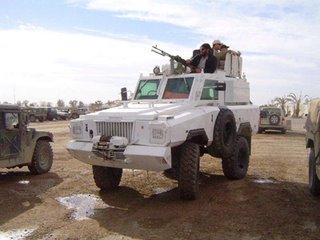
But, what Drayson does not argue – ever – is that the RG-31 would not provide additional protection, nor even that it would not provide complete protection, which has been left for others to do. Some argue that, because it would not protect against the so-called "off-route" mine, we should not use the RG-31, an argument as fatuous as saying that, because a Challenger tank is not proof against an anti-tank missile, they should not be deployed. And, surprise, surprise, guess where the ex-MoD Mamabas are (see above).
But the Minister's arguments (or lack of them) indicate that he is fighting a political agenda on political grounds, and it is Booker who has given us that agenda in today's
Telegraph.

The pity of it is that, in two weeks, Parliament packs up its bags for the summer and the "silly season" takes over, so let's just remind ourselves of what this is all about. (left). Nevertheless, the media – and especially the
Sunday Times - have got their little bit of mileage out of the story, and
the BBC has rushed to the government's defence. The issue will thus peter out, leaving Drayson to breathe a sight of relief while he continues to ignore the welfare and protection of our troops.
But, while the MPs play, as we seen from
from the media today, the situation is becoming highly dangerous in Afghanistan while, in Iraq, the MoD is simply reacting by putting the lid on comment and
controlling access by journalists.
That leaves us to "bang on" but I am sure that, if we continue at this rate, we will eventually lose most of our readers and become just another lonely voice bleating in the dark. Can anyone out there suggest the next move?
COMMENT THREAD
 Mulling over the implications of the Israeli situation, our activities in Iraq, Afghanistan and elsewhere, and following on from my post about the need for new thinking, my deliberations were given a new focus by an e-mail from a reader.
Mulling over the implications of the Israeli situation, our activities in Iraq, Afghanistan and elsewhere, and following on from my post about the need for new thinking, my deliberations were given a new focus by an e-mail from a reader. For this, we are told, there is an urgent need for a number of fast, armed patrol vessels. Such vessels need a flight deck and hangar for an embarked helicopter, plus accommodation for a number of Marines/Special Forces - perhaps an upgraded River Class offshore patrol vessel, or even this little Italian number (below).
For this, we are told, there is an urgent need for a number of fast, armed patrol vessels. Such vessels need a flight deck and hangar for an embarked helicopter, plus accommodation for a number of Marines/Special Forces - perhaps an upgraded River Class offshore patrol vessel, or even this little Italian number (below). In the longer term, this might be cheaper than keeping high-tech, multi-role frigates on station, such as HMS Kent (type pictured, top left) which was recently the lead RN ship in the northern Gulf. On the other hand, additional, dedicated patrol vessels might allow the UK to take a more active role in stopping the oil smuggling which is undermining the Iraqi economy.
In the longer term, this might be cheaper than keeping high-tech, multi-role frigates on station, such as HMS Kent (type pictured, top left) which was recently the lead RN ship in the northern Gulf. On the other hand, additional, dedicated patrol vessels might allow the UK to take a more active role in stopping the oil smuggling which is undermining the Iraqi economy.
